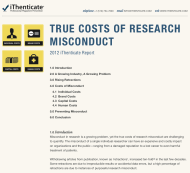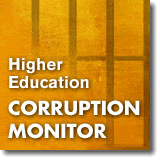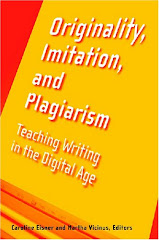March 13, 2009
Plagiarism in the news (CrossRef)
March 10, 2009
Plagiarism and other scientific misconducts
Journal of Cancer Research and Clinical Oncology
K. Höffken and H. Gabbert
When we were young scientists we heard that: ‘‘games authors play’’ and learned that results of scientific work was published by the same authors in different order in different journals. However, the content of the publications differed only slightly from each other (e.g., by omitting one and adding another table or figure) and the conclusions were almost identical.
When we grew older, we encountered affairs of scientific misconduct ranging from copying text from other scientific papers up to faking results.
When we became editors of our journal, we hoped that we would be immune from such assaults. However, we had to learn that each of the above examples of plagiarism and of other scientific misconduct could happen to us. We met double publications, learned that authors sent manuscripts simultaneously to more than one journal or were informed that authors copied and pasted text (as can be seen from the example below).
Original version
Recent technologic advances now make it feasible to better tackle the methodological challenges of detecting EBV in breast cancers. Consequently, a critical next step in understanding this relationship is to apply detection strategies that are sensitive and specific for EBV and able to localize the EBV to particular benign or malignant cells within the tissue. A recent National Cancer Institute recommendation specifies an approach combining real-time quantitative PCR, which allows measurement of the amount of viral DNA in archival tissue samples, with laser capture microdissection to improve localization of viral DNA to benign or malignant components of a tissue sample (90).
Plagiarized version
Recent technological advances now make it feasible to better tackle the methodological challenges of detecting virus in breast cancers. A critical next step in understanding this relationship is to apply detection strategies that are sensitive and specific for virus and able to localize this agent to particular malignant cells within the tissue. A recent National Cancer Institute recommendation specifies an approach combining real-time quantitative PCR, which allows measurement of the amount of viral load in archival tissue samples, with laser capture microdissection to improve localization of viral nucleic acid to benign or malignant components of a tissue sample.
What did we learn from these facts?
1. Science is not immune from fraud, misconduct nor void of bad scientists. Fortunately, these are exemptions!
2. Journals are not protected against these assaults and
3. Even the best prevention system did not exclude that it happened to us and that it will happen again.
What can we do to improve our prevention mechanisms?
1. We count on the readiness and awareness of our readers.
2. We will relentlessly denounce the criminal methods and their originators.
3. We will put the persons on a black list and urge other journals to deny them the right for publication.
Please support us with our efforts. Do not hesitate to inform us about any irregularity, violation or infringement.
J Cancer Res Clin Oncol (2009) 135:327–328
March 9, 2009
Plagiarism in Scientific Publications
Editorial Article
Peter R. Mason
Biomedical Research & Training Institute, Harare, Zimbabwe
J Infect Developing Countries 2009; 3(1):1-4. >>>
March 7, 2009
Combating plagiarism
Nature Photonics 3, 237 (2009)
doi:10.1038/nphoton.2009.48
Accountability of coauthors for scientific misconduct, guest authorship and deliberate or negligent citation plagiarism, highlight the need for accurate author contribution statements.>>>
March 6, 2009
Responding to Possible Plagiarism
- L. Gollogly, H. Momen, Rev. Saude Publica 40, 24 (2006).
- C. White, BMJ 336, 797 (2008).
- M. Errami et al., Bioinformatics 24, 243 (2008).
- Materials and methods are available as supporting material on Science Online.
- J. Lewis, S. Ossowski, J. Hicks, M. Errami, H. R. Garner, Bioinformatics 22, 2298 (2006).
- M. Errami, J. D. Wren, J. M. Hicks, H. R. Garner, Nucleic Acids Res. 35, W12 (2007).
- M. Errami, H. Garner, Nature 451, 397 (2008).
- M. Errami, Z. Sun, T. C. Long, A. C. George, H. R. Garner, Nucleic Acids Res. 37, D921 (2009).
- Journal Citation Reports, ISI Web of Knowledge (Thomson Reuters, Philadelphia, 2008); http://isiwebofknowledge.com/products_tools/analytical/jcr/.
- ISI Web of Knowledge (Thomson Reuters, Philadelphia, 2008); http://isiknowledge.com/.
- Office of Research Integrity (ORI), Managing Allegations of Scientific Misconduct: A Guidance Document for Editors (ORI, U.S. Department of Health and Human Services, Rockville, MD, 2000); http://ori.dhhs.gov/documents/masm_2000.pdf.
- We thank D. Trusty for computer administrative support; J. Loadsman as a substantial contributing curator; W. Fisher for useful comments, discussions, and manuscript editing; D. Wu and W. Fisher for assistance in obtaining full text articles; L. Gunn for administrative assistance; and the numerous Déjà vu users who have reported inaccuracies or have alerted us to questionable publications. This work was funded by NIH grant 5R01LM009758-02, the Hudson Foundation, and the P. O'B. Montgomery Distinguished Chair.
2Division of Translational Research, The University of Texas Southwestern Medical Center, 5323 Harry Hines Boulevard, Dallas, TX 75390-9185, USA.
*Author for correspondence. E-mail: harold.garner@utsouthwestern.edu
March 5, 2009
Study finds plenty of apparent plagiarism (Science News)
Yellow highlights aspects of this paper that copy material published in a previous paper — by other authors.
UT Southwestern Medical Center
March 1, 2009
Borrowing words, or claiming them?
Nature Immunology 10, 225 (2009)
doi:10.1038/ni0309-225
Journals are taking steps to stem of the practice of plagiarism.
Have you ever experienced a sense of déjà vu after reading a colleague's manuscript or researching a topic of interest? A paragraph or entire section sounds eerily familiar—too familiar, perhaps, because it is a word-for-word, verbatim (or nearly so, with a few synonyms tossed in) replication of another piece written by different authors. Or maybe a result or hypothesis is claimed to be 'novel' but in fact others have reported such findings and the previous work is not cited. Or the same data are presented in both earlier and subsequent publications from an author, but the later publication fails to acknowledge the fact that the data were included in the earlier work. Are any of these situations acceptable? In fact they are not. All three scenarios represent examples of what can be considered plagiarism.>>>
Random Posts
Popular Posts
-
This guest post is from Kayhan Kantarlı, a retired professor of physics from the University of Ege in Turkey. He published a first versio...
-
Jeffrey Beall This is a list of questionable, scholarly open-access publishers. I recommend that scholars not do any business with these pu...
-
The Yomiuri Shimbun Turkish national Serkan Anilir, recently stripped of the doctorate he obtained from the University of Tokyo over plagiar...
-
Richard Knox Many online journals are ready to publish bad research in exchange for a credit card number. That's the conclusion o...
-
When Robert Barbato of the E. Philip Saunders College of Business at Rochester Institute of Technology (RIT) heard he was being accused of p...







